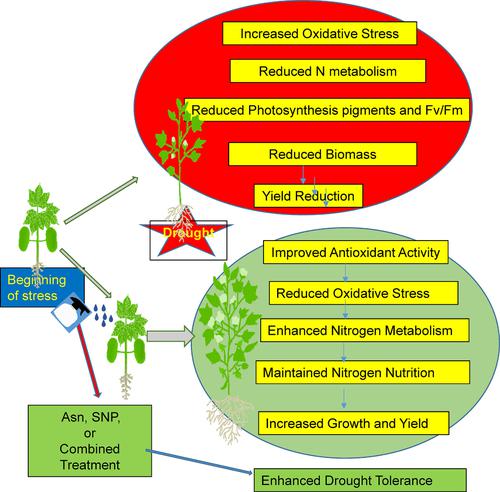当前位置:
X-MOL 学术
›
Food Energy Secur.
›
论文详情
Our official English website, www.x-mol.net, welcomes your feedback! (Note: you will need to create a separate account there.)
Asparagine and nitric oxide jointly enhance antioxidant capacity and nitrogen metabolism to improve drought resistance in cotton: Evidence from long-term field trials
Food and Energy Security ( IF 5 ) Pub Date : 2023-09-12 , DOI: 10.1002/fes3.502 Sabri Akin 1 , Cengiz Kaya 2
Food and Energy Security ( IF 5 ) Pub Date : 2023-09-12 , DOI: 10.1002/fes3.502 Sabri Akin 1 , Cengiz Kaya 2
Affiliation

|
Asparagine (Asn) and nitric oxide (NO) can enhance plant tolerance to abiotic stress, but their interaction is not well understood. Cotton is a vital resource for the textile industry, but its yield is reduced by drought stress, which could threaten its global supply in a warming and stressful world. Improving cotton's drought tolerance is crucial for supporting the textile industry. Two simultaneous field experiments were conducted to study the effect of Asn and sodium nitroprusside (SNP), a NO donor, on cotton's drought tolerance. Two irrigation treatments were applied: control (C: 100% A pan) and drought stress (50% A pan). The plants were also sprayed with two plant stimulants before imposing drought stress: Mock control, 20 mM Asn, and 0.2 mM SNP, either alone or together. Drought stress impaired plant growth, photosynthesis, yield, nitrogen metabolism, and antioxidant defense, while increasing oxidative stress and free amino acid levels. However, Asn and SNP treatments alleviated these negative effects and improved antioxidant enzyme activity, plant growth, yield, and nitrogen content. The Asn + SNP treatment also increased irrigation water productivity under water-limited conditions, suggesting its potential for enhancing water use efficiency in cotton production. The combined treatment was more effective than the single treatments, indicating a synergistic effect of Asn and SNP in enhancing drought tolerance in cotton. These results imply that Asn and SNP could be useful tools for sustaining cotton production under drought conditions by boosting nitrogen metabolism and antioxidant defense, thereby contributing to the global supply of cotton and supporting the textile industry.
中文翻译:

天冬酰胺和一氧化氮共同增强抗氧化能力和氮代谢,提高棉花的抗旱性:长期田间试验的证据
天冬酰胺 (Asn) 和一氧化氮 (NO) 可以增强植物对非生物胁迫的耐受性,但它们的相互作用尚不清楚。棉花是纺织工业的重要资源,但其产量因干旱胁迫而降低,这可能会在气候变暖和压力重重的世界中威胁其全球供应。提高棉花的耐旱性对于支持纺织业至关重要。同时进行了两项田间试验,研究 Asn 和 NO 供体硝普钠 (SNP) 对棉花耐旱性的影响。应用两种灌溉处理:对照(C:100%A盘)和干旱胁迫(50%A盘)。在施加干旱胁迫之前,还向植物喷洒两种植物刺激剂:模拟对照、20 mM Asn 和 0.2 mM SNP,单独或一起喷洒。干旱胁迫损害植物生长、光合作用、产量、氮代谢和抗氧化防御,同时增加氧化胁迫和游离氨基酸水平。然而,Asn 和 SNP 处理减轻了这些负面影响,并提高了抗氧化酶活性、植物生长、产量和氮含量。Asn + SNP 处理还提高了限水条件下的灌溉水生产率,表明其具有提高棉花生产用水效率的潜力。联合处理比单一处理更有效,表明Asn和SNP在增强棉花耐旱性方面具有协同作用。这些结果表明,Asn 和 SNP 可以成为干旱条件下维持棉花生产的有用工具,通过促进氮代谢和抗氧化防御,从而促进全球棉花供应并支持纺织业。
更新日期:2023-09-12
中文翻译:

天冬酰胺和一氧化氮共同增强抗氧化能力和氮代谢,提高棉花的抗旱性:长期田间试验的证据
天冬酰胺 (Asn) 和一氧化氮 (NO) 可以增强植物对非生物胁迫的耐受性,但它们的相互作用尚不清楚。棉花是纺织工业的重要资源,但其产量因干旱胁迫而降低,这可能会在气候变暖和压力重重的世界中威胁其全球供应。提高棉花的耐旱性对于支持纺织业至关重要。同时进行了两项田间试验,研究 Asn 和 NO 供体硝普钠 (SNP) 对棉花耐旱性的影响。应用两种灌溉处理:对照(C:100%A盘)和干旱胁迫(50%A盘)。在施加干旱胁迫之前,还向植物喷洒两种植物刺激剂:模拟对照、20 mM Asn 和 0.2 mM SNP,单独或一起喷洒。干旱胁迫损害植物生长、光合作用、产量、氮代谢和抗氧化防御,同时增加氧化胁迫和游离氨基酸水平。然而,Asn 和 SNP 处理减轻了这些负面影响,并提高了抗氧化酶活性、植物生长、产量和氮含量。Asn + SNP 处理还提高了限水条件下的灌溉水生产率,表明其具有提高棉花生产用水效率的潜力。联合处理比单一处理更有效,表明Asn和SNP在增强棉花耐旱性方面具有协同作用。这些结果表明,Asn 和 SNP 可以成为干旱条件下维持棉花生产的有用工具,通过促进氮代谢和抗氧化防御,从而促进全球棉花供应并支持纺织业。



























 京公网安备 11010802027423号
京公网安备 11010802027423号